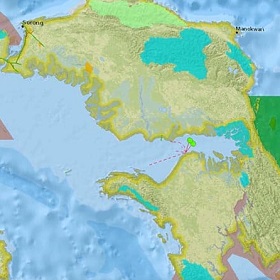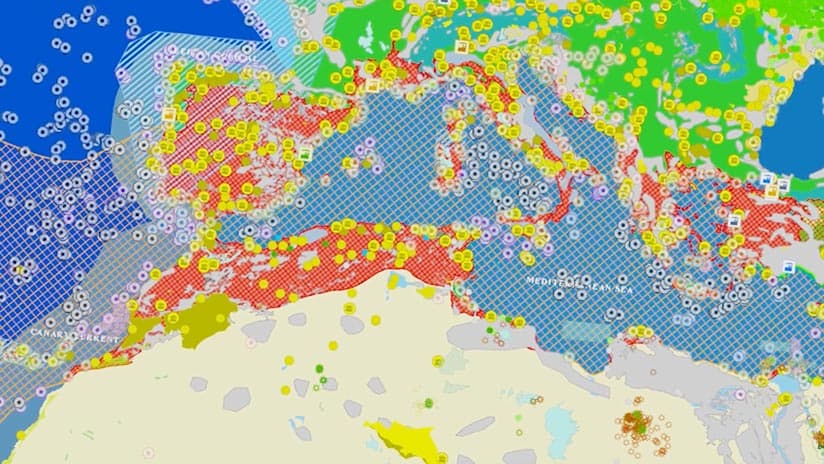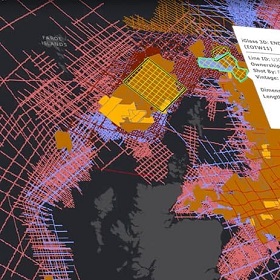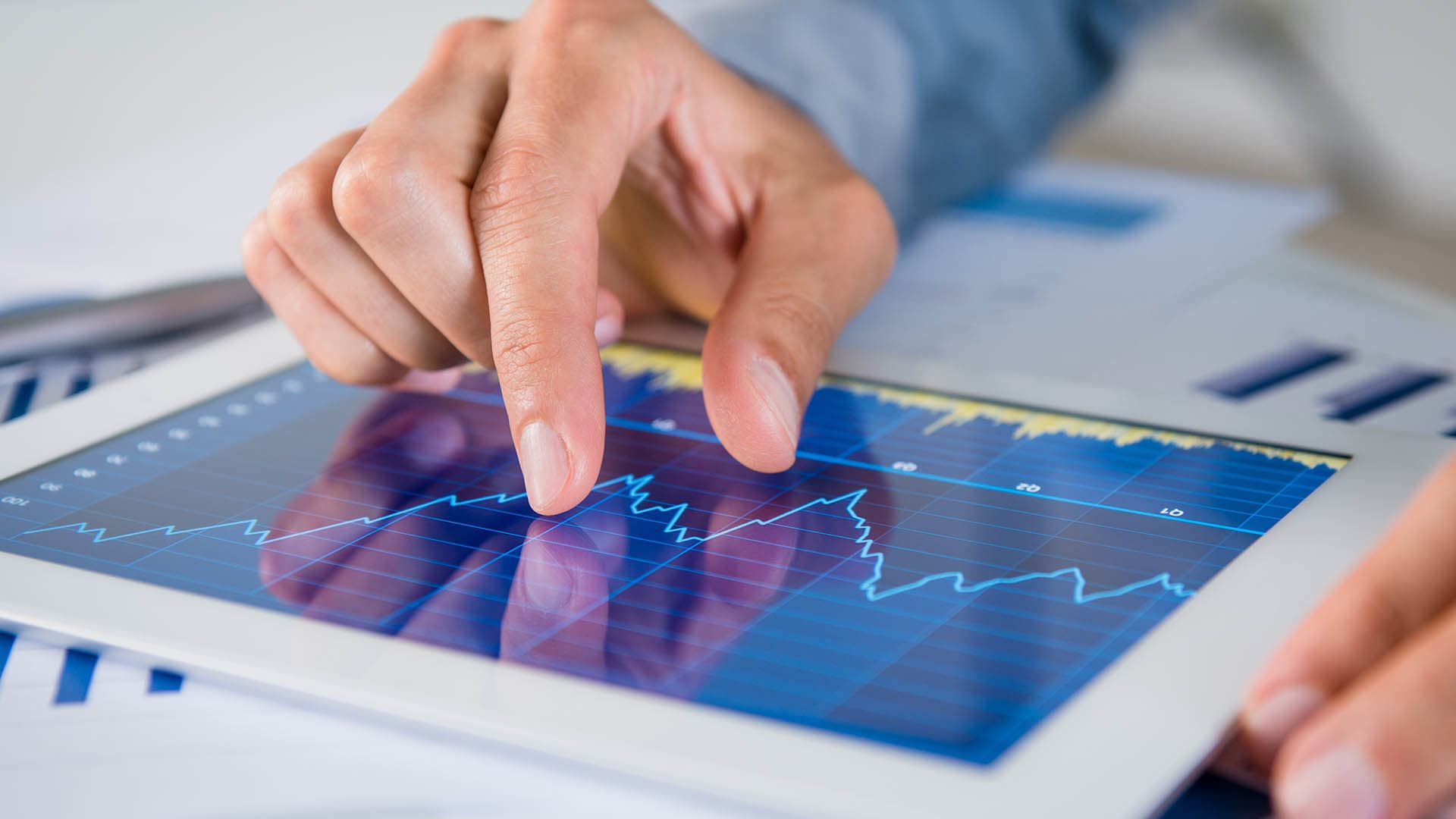Leaders of Fortune 500 companies believe digital transformation is the future of their business. According to Forbes Insights, half of senior executives worldwide, when asked about digital transformation, said that the next two years will be “critical for their organizations in order to make this transition and prepare for future opportunities.”
Here at BP, that means embracing new technologies, including digital, which will improve our ability to monitor, predict, and optimize our business. Ultimately, this digital transformation will enable BP to create more sustainable operations, better manage expenses, and uncover new products and services for customers around the world.
Enacting digital transformation on a global scale is a vast undertaking at BP, a company of more than 70,000 employees dedicated to oil and gas exploration, production, transportation, refining, and retail—with airline and shipping divisions and a growing presence in biofuels and wind energy. Along the way, we’ve learned several valuable lessons that we’ll share here.
At BP, digital transformation takes many forms. We’ll explore it through the lens of location intelligence, which is critical to our business. Location intelligence helps BP professionals track the location and condition of assets; understand in real time the events that shape the regions and neighborhoods where we operate; and identify areas of customer need and business growth.
In short, location intelligence helps us make smart business decisions across the globe.
Becoming a digital energy company required us to overhaul our location intelligence capabilities, and central to that transition was modernizing our geographic information system (GIS) capabilities. The lessons we learned during that implementation—detailed throughout this article—are worth considering for any company that enlists enterprise software to support digital transformation.
Lesson 1: Embrace the enterprise platform
Location intelligence—and the GIS technology that underpins it—has long been crucial to BP’s business. Members of our exploration team use GIS-based maps to plot roads and design new access routes. Our environmental teams use GIS to create impact assessments, while our project teams leverage it to help design and deploy construction projects. GIS is the working geospatial brain that delivers the digital maps and analysis we need to help run a sustainable energy business.
As we set out two years ago to build a new foundation for location intelligence at BP, we systematically embraced an enterprise platform approach to GIS instead of building self-contained solutions for each business case. We wanted our experience with GIS to be similar to our experience with other enterprise technologies.
Over the years, numerous instances of GIS had taken root independently at BP. Businesses had various levels of GIS deployments, and some GIS tools had been built for specific workflows. But all were created at different times, by different teams, with different purposes, and we found ourselves with disconnected data and workflows. We had to support, maintain, and migrate multiple software versions almost constantly, and our total cost of ownership was excessively high.
Adopting a true platform approach has helped reduce those costs. But cost was just the beginning of the benefits. For BP and other companies, an enterprise platform pays dividends in numerous ways:
- The platform delivers faster time to value. BP professionals want decision-support tools that adapt to their changing needs. With an enterprise GIS platform, we can more easily build mapping and analytics apps at the speed of business—in fact, we enable business users themselves to configure lightweight apps rather than enduring longer software development cycles from a central team. By letting the users create the tools they need, a business can quickly convert data and information into insights.
- An enterprise platform speeds up collaboration. For illustration, we can look at BP’s pipeline team, which uses GIS as the system of record on the physical hardware of our pipelines, with details that include the equipment’s size, metal composition, age, and more. The pipeline team also manages conditional data: the type of soil or water nearby, the pipeline’s maintenance history, and more. Others in Upstream also need access to portions of this information, and if those teams are working on separate systems, additional effort is required to export, translate, and load data from one system to the others, which can take hours or even days. When they’re on an enterprise GIS platform, those two teams can share the same location intelligence immediately, leading to quicker access, efficient analytics, and more informed decisions.
- The platform creates a virtuous cycle for geospatial information. We’ve seen many instances where a dataset that was considered basic information for one team turns out to be very valuable to another team. For instance, activities that we track in our Upstream business turned out to be very valuable intelligence to our Downstream teams. These two parts of the business may otherwise have had limited interaction. But with shared data on a common GIS mapping platform, users are now able to see the data resources available and use information from other teams. As a result, traditional organizational siloes have started to dissolve. That, in turn, has led to new efficiencies, insights, and business opportunities. We see this happening across teams and geographies.
In the enterprise platform, we give each business entity its own space to manage its data, workflows, analytics, and publishing. As a result, data and information are more accessible across the organization, leading to more opportunities to collaborate. This drives more value from each dataset and creates the virtuous cycle of new capabilities and opportunities that may have been missed.
For these reasons and more, we believe providing a company-wide geospatial platform—rather than building specific solutions—will lead to more sustainability and a larger return for an organization. The additional lessons below explain some of the learnings and best practices we have found while creating a successful and sustainable location intelligence system.
Lesson 2: When you’re everywhere, you’re nowhere
Location intelligence and GIS technology are leveraged across BP, and this diverse use creates a paradox that companies often experience with other enterprise technologies: because the technology is needed everywhere, it is owned nowhere.
Historically in many companies, the IT department—because it serves all the company’s businesses—has stepped in as the foster parent for enterprise software platforms. While this has been a successful model for enterprise tools with defined access and workflows, the model does not work as well for platforms with an open data structure and a nearly unlimited set of use cases.
An enterprise platform, by definition, is a tool that can be used in many ways. In the case of a geospatial platform, the use cases are especially diverse. At different times and for different parts of the business, the platform can act as a system of record, a system of engagement, and a system of insight. In light of this, we believe a location intelligence platform should be placed in the business function as close to the core business as possible, where they benefit from in-depth business knowledge, workflow understanding, geospatial data skills, and competence in the toolkit.
Regardless of where the platform is hosted, deep collaboration with the Information Technology and Systems (IT&S) organization is still crucial in delivering the technology platform. IT&S helps us deploy the right hardware, architect the most efficient system design, manage network and storage needs, and take care of the software portfolio.
As we implemented our location-based platform, we relied on a virtual geospatial project team composed of IT&S and business professionals to increase engagement, communication, and collaboration.
Deciding which part of the business organization should take ownership of the geospatial capabilities will be different for almost every company due to organizational structure, primary user groups, budgetary capabilities, and other concerns. For BP, the GIS platform found its initial home in the subsurface business under the Upstream segment.
Lesson 3: Set your data free
While the platform approach creates new opportunities by making data formats and services interoperable between our teams and functions, it also introduces new collaboration challenges.
BP has always had a mix of confidential data in our work. Historically, we have locked access to much of our data, either because of limitations in the technology or a “better safe than sorry” approach. Unfortunately, this resulted in duplication of data across projects and teams.
In the geospatial domain, this becomes a sizable issue. We found multiple files for the same pipeline locations, the same wells, etc. We also found subtle changes within some of the files. In many cases, the person who made the copy of the data moved on, and the team continued to use the information, assuming it was the most current version. This is not ideal in any digital transformation.
At BP, the reality is that 95 percent of the geospatial data we use can be shared across the entire organization; only a few key datasets need to be locked down. The solution was to challenge the status quo and open all data by default, allowing it to be available and shareable for multiple teams and diverse workflows. This helped power the virtuous cycle of use. Our advice to other executives is to lock down processes and data where required but leave the rest open to provide plenty of room for exploration and innovation. This is what drives new workflows, insights, and the greatest value from the enterprise platform.
That said, we needed to consider how to present data in the right way to help users of the open platform find the most appropriate information for their use case. This is an evolving effort. The solution for now is to tag “admin” items and encourage the use of metadata elements. Simple summaries and basic data quality metrics help ensure that users are more informed when making data choices. This leads to the next lesson: Let your users get their hands dirty.

You need to win user trust and acceptance quickly—don't just throw them an enterprise platform and say 'go.' Orient them first, because trust is easy to lose and exponentially harder to regain.
Lesson 4: Let business users extend the platform
Several years ago, when our GIS provider Esri predicted that our users would soon be able to create targeted apps for many of our location intelligence needs, I was skeptical. At that time, the thought of an end user being able to create apps seemed impossible, but now this is exactly what we see happening. This evolution is enabling almost anyone to build apps and workflows faster than we could produce in a central team, and this is making our business smarter and faster than ever.
Through today’s digital software platforms, app development is lightweight, code free, and user driven. This means business users acting as “citizen developers” can configure the platform to perform analytics and create insights at the pace of business. When all your professionals have the access to configure what they need, the value to a company grows exponentially.
This capability demanded another significant change in how we deploy and support GIS technology here at BP. We have truly opened the platform to our entire company. As we began the rollout, we gave business users a basic orientation on how to configure and create apps and then said, “Here’s the playground. Do what you need to do to solve your business problems.”
They responded eagerly. We are seeing hundreds of maps, apps, and dashboards emerge across our platform, many of which would only have been possible—under the prior way of working—after a user manually retrieved and reviewed various paper and/or digital projects and maps.
This is a powerful example of how our users are configuring location intelligence apps to make better decisions. When that is scaled across tens of thousands of employees, the results are a diversity of ideas, an informed focus on integrated business workflows, gains in productivity, reduced risk, and business agility.
The One Map platform facilitates this on a daily basis. And yet there is a lesson lurking on the flip side of that revelation: Once business users begin creating their own apps, the support team must keep up with them, not vice versa. Mindful that users can quickly lose trust in software platforms that don’t support their needs, we needed to make another significant change in our approach, and this leads to the next lesson: Supporting an enterprise platform.
Lesson 5: System and user support in this new paradigm
Typically, when a company deploys a software solution, the deployment team relies on an install manual and a standard database and format. The setup usually includes a support desk for users, with a few scripts to follow for common workflows. In the worst-case scenario, a vendor support desk might be needed to help with a software issue or tough workflow definition.
In the case of a geospatial platform, there is none of that. Instead, there are different levels of technology, various platforms to deploy on, a massive and diverse set of unknown workflows, and numerous data formats to oversee. Different versions of information emerge over time, and each version can be perfectly valid, depending on the use case.

The team that supports an enterprise platform with all these challenges across a global enterprise needs to be as knowledgeable as its user community. That means understanding the technology, the application use cases, data formats and workflows, analytics and displays, and even basic cartography.
Close collaboration between the IT and business organizations helps create the support structure that is critical to achieving enterprise platform success and sustainable results.
Lesson 6: Automation
I cannot stress enough the role that automation plays in a successful geospatial platform deployment. In all my years of working in this field, I have never heard an internal customer say, “Thank you, that’s all I needed.” Everything we touch tends to grow and evolve quickly or spawn a similar effort—all of which leads to more work for the team. This is a great indicator that the team is adding value and the platform is having a positive impact. But without good management, the team can consume all its available resources on new ideas, leaving the core platform to suffer.
To counter that, the BP team created a golden rule early on: If there’s a chance that a workflow will be needed again, automate it the first time. Automation helps on many levels. It ensures consistency and facilitates continuous improvements. It allows more transparent tracking and reporting of process status. Most importantly, it allows a company to run many more processes than could ever be achieved with hands on keyboards. We now run hundreds of automations around the company, with some firing every few seconds and others only a few times a year.
The lesson we learned was to invest as much thought in the automation platform as in the GIS technology itself.
Lesson 7: Marketing matters
When a company deploys an enterprise platform to tens of thousands of employees—whether it’s GIS, ERP, or another technology—branding, marketing, and communications matter. Here are several marketing lessons we learned during our digital transformation:
- Build an identity: To get traction on the big initiatives, create a program brand that users can identify with. We dubbed our GIS platform One Map, which highlighted the theme of a single mapping infrastructure for all of our location intelligence. We then promoted the program identity, rather than the GIS technology behind it.
- Mind your language: At BP, as at any company, executives and professionals tend to think about GIS or ERP as they think about PowerPoint or Word. In other words, applications aren’t particularly important to them; business results are. So, when we began our enterprise platform rollout, we avoided the term GIS in promotional materials. Instead, we spoke to users in language that resonated with them. When we talked to the IT people, we described systems of record, systems of insights, and platforms. When we talked to the business people, we stressed production optimization, safety and efficiency, access to information, advanced analytics and dashboards, and overall quicker time to decisions.
- Communicate: Our One Map launch campaign deployed emails, posters, and flyers in every BP office around the world, as well as advertisements on office televisions, to convey the business benefits of One Map and get BP professionals excited to leverage it. We also created three levels of internal websites. A high-level website conveyed a generic message about location management and analytics and how those tools are used in our company. Another site, titled Community of Practice, was tailored to our technical-savvy data and information professionals. Lastly, a tools dashboard allowed users to dive into specific tools, data models, and workflows in support of specific work. Communication is ongoing and includes regular Yammer posts, news stories, and internal articles. The learning here is to ensure that there is a budget for communication, resources assigned to it, a plan for ongoing engagement, and a concerted effort to end every communication with a call to action.
Lesson 8: Measure success
It can be difficult to measure the impact of something as vast as a location intelligence platform for more than 70,000 employees spread across the world, but it is important to ensure ongoing internal support. One simple way to gauge success is to monitor how many employees become active users of the platform and its apps. At BP, more than 7,000 users signed up to use the GIS platform before we launched our communications campaign, strictly through social channels and other digital sharing. Now, just four months since launch, more than 10,000 users have accessed the system.
Given the diversity of use and the size of the global community, we are now taking our tracking and reporting to new levels of detail, including tracking users, datasets, services, maps, apps, and more on a daily level. These metrics help ensure that we can communicate the impact of the platform, but they also assist in our support of the system. With these details, we can drive better hardware and software decisions, understand which datasets are used more or less than others, as well as see when a technical community is more active in one region than another, signaling that we may need to organize targeted knowledge-share sessions.
Another key way to measure success is by efficiencies gained. If someone at BP can access the data they need without having to load it manually, and users can quickly configure the functionality needed to analyze it, and then decide how to communicate it through maps, apps, or dashboards, we might improve that person’s annual efficiency by 3–5 percent. For a technical worker who needs location intelligence more often, it might be 5–8 percent. Since these gains come from a shared enterprise platform where an app or dashboard can be leveraged in similar workflows, the percentage gain is almost assuredly higher.
When executives add up these productivity gains, factor in the average resource salary and the number of people leveraging the system, and follow progress over time, they can begin to put a number on what a company gains from approaching location intelligence with a geospatial platform over bespoke solutions.

By going to an enterprise platform, sharing information within geographies and across divisions, we have greatly reduced startup time for new analytics projects. Now, more data is available on a platform that's faster to access and use, and, therefore, people can find better insight and drive better decisions.
Our next steps
Digital transformation, whether via GIS, ERP, or another enterprise system, is not the destination. It’s the means to solving business problems by leveraging digital systems and integrated workflows. Given the nature of digital systems, organizations must engage in an ever-evolving effort to update, maintain, and deliver needed capabilities.
Our initial deployments were predominately internally hosted systems, but as we begin to envision the next generation of our platform architecture, we want to move more infrastructure onto the cloud, so our users can access GIS-driven data and apps on any device, anytime, anywhere.
As we have watched the technology evolve, we have also seen the industry’s application of location intelligence change. We believe the number of use cases for location data, analytics, and visualization is about to explode in several areas of our business.
Augmented reality (AR) and virtual reality (VR) techniques are beginning to merge with BP’s traditional location-based systems. We are placing sensors on many assets, stationary and mobile, and linking them to real-time Internet of Things (IoT) frameworks. Our building information systems are also beginning to link with real-world geography.
Imagine the efficiency gains we could achieve if an oil field technician could view real-time conditions, whether on a laptop, a tablet, Google Glass, or even an AR/VR display, in the office or the field. In this real-time display, they could view equipment maintenance history, health status, operating parameters, user manuals, or even click a button to kick off a replacement activity—which would integrate with the planning process and send an equipment order to the procurement system. To achieve this, the user needs to be able to track location in the real world, inside the fence line, inside the building, and back again. This will require a level of geospatial awareness, capability, and integration we have not yet seen in our industry.
Many executives might read this and think, “It must have been easy for BP because they had millions of dollars and hundreds of people working on this location intelligence platform.” In reality, we had a very small budget and only five people working to start the platform. We delivered to scale by rethinking some of our traditional approaches to geospatial capabilities. We focused on platform over solution and worked to enable a larger community of users across the business who could drive BP’s data, analytics, and apps forward.
For companies working to achieve sustainable digital transformation in the geospatial domain, the enterprise platform approach is worth exploration. Here at BP, we’ve found that it’s an effective way to distribute the technology throughout the company and multiply its benefits exponentially across our business.
The Esri Brief
Trending insights from WhereNext and other leading publicationsTrending articles

December 5, 2024 |

July 25, 2023 |

April 1, 2025 |

November 12, 2018 |

February 1, 2022 |

April 16, 2024 |





